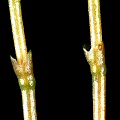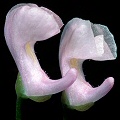| Utricularia section Lecticula | ||
|---|---|---|
| Species | Range | Habit1 |
| U. resupinata | North America, Central America | SAA |
| U. spruceana | Brazil, Venezuela | SAA |
| 1SAA=subaffixed aquatic. | ||
Q: About Utricularia subgenus Utricularia section Lecticula
A: I love the plants in this section because the flowers are so strange. However, from a taxonomic
perspective, the feature that characterizes the species in
this section is that the floral bracts are fused into a kind of cone that encircles the entire flower stalk. No other
Utricularia have bracts like this.
Another interesting thing about these plants is that the leaves have little joint lines at points along the segments, which I
believe is again unique to this section.
Utricularia resupinata
A plant that has strangly asymmetric flowers--one petal is usually flipped up
while the other flops downwards. These plants relish extremely shallow water, and have threadlike leaves which emerge from the
muck, and pass through the layer of shallow water and rise into the air.
The tips of the leaves usually bear a cluster of inexplicable brown cells. When the water dries up, the plants often
respond by flowering like mad in the hardening mud.
The range for Utricularia resupinata
in North America is weird. It occurs in Canada and northeastern USA down to Maryland and Pennnsylvania. Then, it skips
several states and reappears in Florida and Georgia. In Central
America it is in Cuba, Belize, and Nicaragua. I have grown plants from Michigan and Florida, side by side for about a decade, and
while they have some differences, they behave essentially the same.
Utricularia spruceana
I have not seen this plant, and as far as I know it has only been collected
three times. It is very much like Utricularia resupinata, but the leaves are multiply divided. I
do not think they have the little bundle of brown cells at the leaf tips.
Page citations: Rice, B.A. 2006a; Taylor, P. 1989; personal observations.

